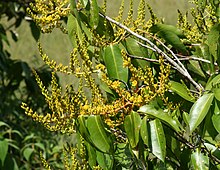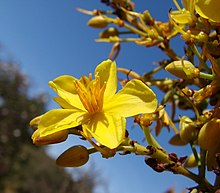| Ouratea | |
|---|---|
 | |
| Ouratea brevicalyx leaves and inflorescences | |
| Scientific classification | |
| Kingdom: | Plantae |
| Clade: | Tracheophytes |
| Clade: | Angiosperms |
| Clade: | Eudicots |
| Clade: | Rosids |
| Order: | Malpighiales |
| Family: | Ochnaceae |
| Subfamily: | Ochnoideae |
| Tribe: | Ochneae |
| Subtribe: | Ochninae |
| Genus: | Ouratea Aubl. |
| Synonyms [1] | |
| |
Ouratea is a genus of flowering plants in the family Ochnaceae. [2] [3] It includes over 290 species native to the tropical Americas, from Mexico and Cuba to southern Brazil, to Cameroon and Gabon in West-Central Africa, and to Ascension Island in the South Atlantic. Most species are native to the Americas. There are two African species, Ouratea batesii and Ouratea stenophylla , and Ouratea lessonii is endemic to Ascension. [1] Many genera have been brought into synonymy with Ouratea, including Gomphia. [1]
